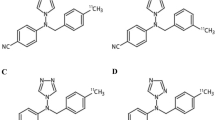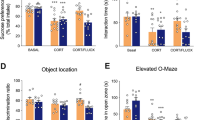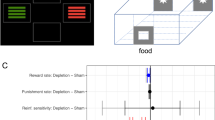Abstract
Twelve male, fasted, anesthetized rhesus monkeys were studied with positron emission tomography (PET) and [11C]α-methyl-L-tryptophan (αMTP) to determine serotonin synthesis rates as described by Diksic et al. (1991). It was expected that the serotonin synthesis rates determined for the whole brain would be correlated with CSF 5-hydroxyindole-3-acetic acid concentrations, a measure of central serotonin turnover, because both measures were obtained at steady state. However, no significant correlation was found. During data analysis, it was noticed that the calculated serotonin synthesis rates were significantly correlated to free plasma tryptophan (TP) concentrations (r = 0.88, p < .001). From repeat scans conducted in six monkeys, it was determined that day-to-day variability in free plasma TP and the percentage of protein binding (average percent difference was 48 and 37%, respectively) produced most of the variability in the calculated serotonin synthesis rates (50%); repeat K images, obtained from the PET data alone, differed by only 11%. Calculated serotonin synthesis rates reported for [11C]αMTP PET studies of humans (Nishizawa et al. 1997) and dogs (Diksic et al. 1991) were also highly correlated to reported differences in plasma free TP concentrations. It seems that the [11C]αMTP model for the computation of serotonin synthesis rates is very dependent on plasma free TP concentration and that it may not accurately determine actual serotonin synthesis rates.
Similar content being viewed by others
Log in or create a free account to read this content
Gain free access to this article, as well as selected content from this journal and more on nature.com
or
References
Ashley DV, Leathwood PD, Moennoz D . (1984): Carbohydrate meal increased brain 5-hydroxytryptamine synthesis in the adult rat only after prolonged fasting. In Schlossberger HG, Kochen W, Linzen B, Steinhart H,(eds), Progress in Tryptophan and Serotonin Research. Berlin, de Gruyter, pp 591–594
Benkelfat C, Ellenbogen M, Dean P, Palmour R, Young S . (1994): Mood-lowering effect of tryptophan depletion—Enhanced susceptibility in young men at genetic risk for major affective disorders. Arch Gen Psychiat 51: 687–697
Brown GL, Goodwin FK, Ballenger JC, Goyer PF, Major LF . (1979): Aggression in humans correlates with cerebrospinal fluid amine metabolites. Psychiat Res 1: 131–139
Caballero B, Gleason R, Wurtman R . (1991): Plasma amino acid concentrations in healthy elderly men and women. Amer J Clin Nutr 53: 1249–1252
Colmenares JL, Wurtman RJ, Fernstrom JD . (1975): Effect of ingestion of a carbohydrate–fat meal on the levels and synthesis of 5-hydroxyindoles in various regions of the rat central nervous system. J Neurochem 25: 825–829
Curzon G, Marsden CA . (1975): Metabolism of a tryptophan load in the hypothalamus and other brain regions. J Neurochem 25: 251–256
Delgado PL, Charney DS, Price LH, Landis H, Heninger GR . (1989): Neuroendocrine and behavioral effects of dietary tryptophan restriction in healthy subjects. Life Sci 45: 2323–2332
Diksic M, Nagahiro S, Chaly T, Sourkes TL, Yamamoto YL, Feindel W . (1991): Serotonin synthesis rate measured in living dog brain by positron emission tomography. J Neurochem 56: 153–162
Diksic M, Nagahiro S, Sourkes TL, Yamamoto L . (1990): A new method to measure brain serotonin synthesis in vivo. I. Theory and basic data for a biological model. J Cereb Blood Flow Metab 10: 1–12
Eccleston D, Ashcroft GW, Crawford TBB . (1965): 5-Hydroxyindole metabolism in rat brain. A study of intermediate metabolism using the technique of tryptophan loading—II. J Neurochem 12: 493–503
Eccleston D, Ashcroft GW, Moir ATB, Parker-Rhodes A, Lutz W, O'Mahoney DP . (1968): A comparison of 5-hydroxyindoles in various regions of dog brain and cerebrospinal fluid. J Neurochem 15: 947–957
Ellenbogen MA, Young SN, Dean P, Palmour RM, Benkelfat C . (1996): Mood responses to acute tryptophan depletion in healthy volunteers: Sex difference and temporal stability. Neuropsychopharmacology 15: 465–474
Fernstrom JD . (1987): Food-induced changes in brain serotonin synthesis: Is there a relationship to appetite for specific macronutrients? Appetite 8: 163–182
Fernstrom JD, Wurtman RJ . (1971): Brain serotonin content: Physiological dependence on plasma tryptophan levels. Science 178: 149–152
Fernstrom JD, Wurtman RJ . (1972): Brain serotonin content: Physiological regulation by plasma neutral amino acids. Science 178: 414–416
Hamon M, Glowinski J . (1974): Regulation of serotonin synthesis. Life Sci 15: 1533–1548
Higley JD, King S Jr, Hasert MF, Champoux M, Suomi SJ, Linnoila M . (1996): Stability of interindividual differences in serotonin function and its relationship to severe aggression and competent social behavior in rhesus macaque females. Neuropsychopharmacology 14: 67–76
Higley JD, Mehlman PT, Higley SB, Fernald B, Vickers J, Lindell SG, Taub DM, Suomi SJ, Linnoila M . (1996): Excessive mortality in young free-ranging male nonhuman primates with low cerebrospinal fluid 5-hydroxydoleacetic acid concentrations. Arch Gen Psychiat 53: 537–543
Higley JD, Mehlman PT, Poland RE, Taub DM, Vickers J, Suomi SJ, Linnoila M . (1996): CSF testosterone and 5-HIAA correlate with different types of aggressive behaviors. Biol Psychiat 40: 1067–1082
Higley JD, Suomi SJ, Linnoila M . (1996): A nonhuman primate model of type II alcoholism? Part 2. Diminished social competence and excessive aggression correlates with low cerebrospinal fluid 5-hydroxyindoleacetic acid concentrations. Alcohol Clin Exp Res 20: 643–650
Higley JD, Suomi SJ, Linnoila M . (1996): A nonhuman primate model of type II excessive alcohol consumption? Part 1. Low cerebrospinal fluid 5-hydroxyindoleacetic acid concentrations and diminished social competence correlate with excessive alcohol consumption. Alcohol Clin Exp Res 20: 629–642
Leathwood PD . (1987): Tryptophan availability and serotonin synthesis. Proc Nutr Soc 46: 143–156
Leathwood PD, Fernstrom JD . (1990): Effect of an oral tryptophan/carbohydrate load on tryptophan, large neutral amino acid, and serotonin and 5-hydroxyindolacetic acid levels in monkey brain. J Neural Transm 79: 25–34
Linnoila M, DeJong J, Virkkunen M . (1989): Monoamines, glucose metabolism, and impulse control. Psychopharmacol Bull 25: 404–406
Linnoila M, Vikkunen M, Scheinin M, Muutila A, Rimon R, Goodwin FK . (1983): Low cerebrospinal fluid 5-hydroxyindolacetic acid concentration differentiates impulsive from nonimpulsive violent behavior. Life Sci 33: 2609–2614
Lucini V, Lucca A, Catalano M, Smeraldi E . (1996): Predictive value of tryptophan/large neutral amino acids ratio to antidepressant response. J Affective Disord 36: 129–133
Maes M, Scharpé S, Verkerk R, D'Hondt P, Peeters D, Cosyns P, Thompson P, De Meyer F, Wauters A, Neels H . (1995): Seasonal variation in plasma L-tryptophan availability in healthy volunteers. Arch Gen Psychiat 52: 937–946
Moir ATB, Eccleston D . (1968): The effects of precursor loading in the cerebral metabolism of 5 hydroxyindoles. J Neurochem 15: 1093–1108
Møller SE, Mortensen EL, Breum L, Alling C, Larsen OG, Bøge-Rasmussen T, Jensen C, Bennicke K . (1996): Aggression and personality: Association with amino acids and monoamine metabolites. Psycholog Med 26: 323–331
Muzik O, Chugani DC, Chakraborty P, Mangner T, Chugani HT . (1997): Analysis of [C-11]alpha-methyl-tryptophan kinetics for the estimation of serotonin synthesis rate in vivo. J Cereb Blood Flow Metab 17: 659–669
Nagahiro S, Takada A, Diksic M, Sourkes T, Missala K, Yamamoto Y . (1990): In vivo measurement of the rate of synthesis of brain serotonin by autoradiography: II. A practical method tested in normal and lithium-treated rats. J Cereb Blood Flow Metab 10: 13–21
Neumeister A, Praschak-Rieder N, Heßelmann B, Rao M, Glück J, Kasper S . (1997): Effects of tryptophan depletion on drug-free patients with seasonal affective disorder during a stable response to bright light therapy. Arch Gen Psychiat 54: 133–138
Nishizawa S, Benkelfat C, Young SN, Leyton M, Mzengeza S, de Montigny C, Blier P, Diksic M . (1997): Differences between males and females in rates of serotonin synthesis in human brain. Proc Natl Acad Sci USA 94: 5308–5313
Pardridge WM, Fierer G . (1990): Transport of tryptophan into brain from the circulating, albumin-bound pool in rats and in rabbits. J Neurochem 54: 971–976
Patlak CS, Blasberg RG, Fenstermacher JD . (1983): Graphical evaluation of blood-to-brain transfer constants from multiple-time uptake data. J Cereb Blood Flow Metab 3: 1–7
Polinsky RJ, Brown R, Burns R, Harvey-White J, Kopin IJ . (1988): Low lumbar CSF levels of homovanillic acid and 5-hydroxyindoleacetic acid in multiple system atrophy with autonomic failure. J Neurol Neurosurg Psychiat 51: 914–919
Post RM, Goodwin FK . (1975): Studies on CSF amine metabolites in depressive patients: Conceptual problems and theoretical implications. In Mendels J (ed), The Psychobiology of Depression. New York, Spectrum Publications, pp 47–67
Schmall B, Shoaf SE, Carson RE, Herscovitch P, Sha L, Eckelman WC . (1995): Separation of racemic α-methyl-tryptophan into its L- and D-isomers and synthesis of α-(11C-methyl)-L-tryptophan. J Labelled Comp Radiopharmaceut 37: 689–691
Shoaf SE, Schmall B . (1996): Pharmacokinetics of α-methyl-L-tryptophan in rhesus monkeys and calculation of the lumped constant for estimating the rate of serotonin synthesis. J Pharmacol Exp Therap 277: 219–224
Sokoloff L, Reivich M, Kennedy C, Des Rosiers MH, Patlak CS, Pettigrew KD, Sakurada O, Shinohara M . (1977): The [14C]deoxyglucose method for the measurement of local cerebral glucose utilization: Theory, procedure, and normal values in the conscious and anesthetized albino rat. J Neurochem 28: 897–916
Teff KL, Young SN, Marchand L, Botez MI . (1989): Acute effect of protein or carbohydrate breakfasts on human cerebrospinal fluid monoamine precursor and metabolite levels. J Neurochem 52: 235–241
Ternaux JP, Boireau A, Bourgoin S, Manon M, Hery F, Glowinski J . (1976): In vivo release of 5-HT in the lateral ventricle of the rat: Effects of 5-hydroxytryptophan and tryptophan. Brain Res 101: 533–548
Thévanaz P, Ruttimann UE, Unser M . (1995): Iterative multi-scale registration without landmarks. In Proceedings International Conference on Image Processing. Los Alamitos, CA, IEEE Computer Society Press, pp 228–231
Yuwiler A, Oldendorf WH, Geller E, Braun L . (1977): Effect of albumin biding and amino acid competition on tryptophan uptake into brain. J Neurochem 28: 1015–1023
Acknowledgements
We thank the staff of the NIH PET Department, the surgical group of the NCRR Veterinary Resources Program, and the staff of NIH Animal Transportation.
Author information
Authors and Affiliations
Rights and permissions
About this article
Cite this article
Shoaf, S., Carson, R., Hommer, D. et al. Brain Serotonin Synthesis Rates in Rhesus Monkeys Determined by [11C]α-Methyl-L-Tryptophan and Positron Emission Tomography Compared to CSF 5-Hydroxyindole-3-Acetic Acid Concentrations. Neuropsychopharmacol 19, 345–353 (1998). https://doi.org/10.1016/S0893-133X(98)00032-3
Received:
Revised:
Accepted:
Issue date:
DOI: https://doi.org/10.1016/S0893-133X(98)00032-3
Keywords
This article is cited by
-
Tryptophan hydroxylase2 gene polymorphisms predict brain serotonin synthesis in the orbitofrontal cortex in humans
Molecular Psychiatry (2012)
-
Measuring serotonin synthesis: from conventional methods to PET tracers and their (pre)clinical implications
European Journal of Nuclear Medicine and Molecular Imaging (2011)
-
5-Hydroxy-l-[β-11C]tryptophan versus α-[11C]Methyl-l-tryptophan for Positron Emission Tomography Imaging of Serotonin Synthesis Capacity in the Rhesus Monkey Brain
Journal of Cerebral Blood Flow & Metabolism (2007)
-
Stability of α-[11C]methyl-l-tryptophan brain trapping in healthy male volunteers
European Journal of Nuclear Medicine and Molecular Imaging (2005)



